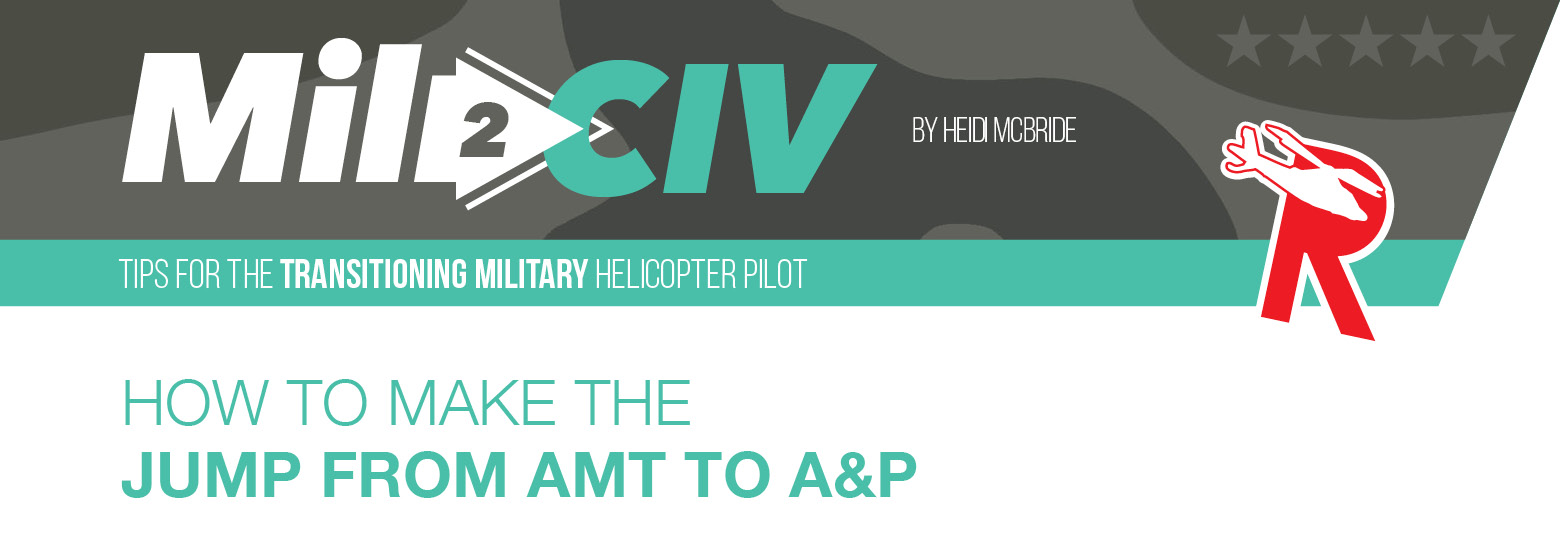|
Sep
16
2020
|
|
Posted 5 years 108 days ago ago by Admin
|
|

His commanding officer asked Travis Coil, a 4-year air defense artillery Army veteran, what he needed to do in order to convince him to re-enlist. Travis answered, “A $2 million re-enlistment bonus and a two week vacation in Hawaii.” Fourteen years of civilian life later, Travis is now an outstanding and highly qualified A&P mechanic who has worked in a variety of fields within the helicopter industry.
Many of us may relate to Travis’ sentiment about exiting the service ASAP, while others may be content spending a few more years active duty. However, if you are seriously considering the idea of transitioning into a civilian aviation maintenance career, here are some steps you will be required to take in order to make a successful transition and be issued your civilian airframe and powerplant (A&P) license.
The A&P license is what authorizes a mechanic to perform and sign off all maintenance completed on FAA registered aircraft. Without this license, you are severely limited in your capabilities. You will need at least 30 months of aircraft maintenance experience in order to be approved for both the airframe and the powerplant portions of this license. Here are a few methods you can use to get that experience.
Method One: Use your military aviation maintenance training and experience. Once you meet the experience requirements, it is time to contact your local FAA Flight Standards District Office (FSDO) to set up an appointment with a primary maintenance inspector (PMI). If you meet the requirements for both your airframe and powerplant license, then the PMI will issue you two copies of a signed FAA 8610 form. Do not lose these copies! You will need to produce both copies of this document in order to take your three written tests as well as your oral and practical exam with a designated maintenance examiner (DME). The DME will issue your A&P license after the successful completion of your exam.
Important: Bring printed copies of the maintenance actions you have performed and signed off to the meeting with the PMI; when you meet with the PMI he is going to request your military ‘rate’ or ‘designation.’ He will then open his big fancy book and look up that designation. The book will tell him, generally, what kind of maintenance you have likely done and whether you qualify for both portions of the airframe and powerplant license. If you know that you have powerplant experience, but the PMI’s fancy book does not indicate your designation would expose you to this type of work, then you must personally show him proof of that experience. Otherwise, he may only authorize you to receive your airframe license.
Method Two: Enroll in a VA-approved airframe and powerplant vocational school. This is particularly useful if you do not have an aviation maintenance background. The VA will pay for this training under the Montgomery GI Bill, Post 911 GI Bill or vocational rehab for disabled veterans. These vocational schools will give you all the necessary training and experience needed to obtain your A&P license.
Method Three: Work as a helper in a maintenance shop under a qualified A&P mechanic. You will need to keep a record or maintenance logbook itemizing the kind of maintenance you performed. These tasks will then be signed by the qualified A&P mechanic. Once you have accumulated 30 months of experience, you follow the same process found above and contact a PMI at your local FSDO in order to obtain your signed 8610 forms.
Next, come to the Military to Civilian Transition course at Heli Expo! Meet folks just like you who have been in your shoes and have made a successful shift to the civilian sector. This is a fantastic opportunity to have your many questions answered, get help with creating a successful resume, and gain insight to the amazing aviation world outside the military.
About the Author: Heidi McBride is an 8 year veteran of the U.S. Coast Guard. She served as an avionics technician and crew chief on the MH-60 Jay Hawk. She transitioned to the civilian sector in 2009, began flight school in 2011 and obtained her A&P license in 2017. She is currently a VFR captain in the AW119 serving the oil and gas industry and loving life!